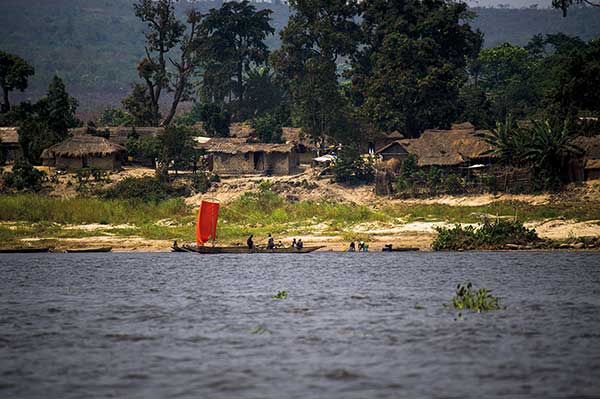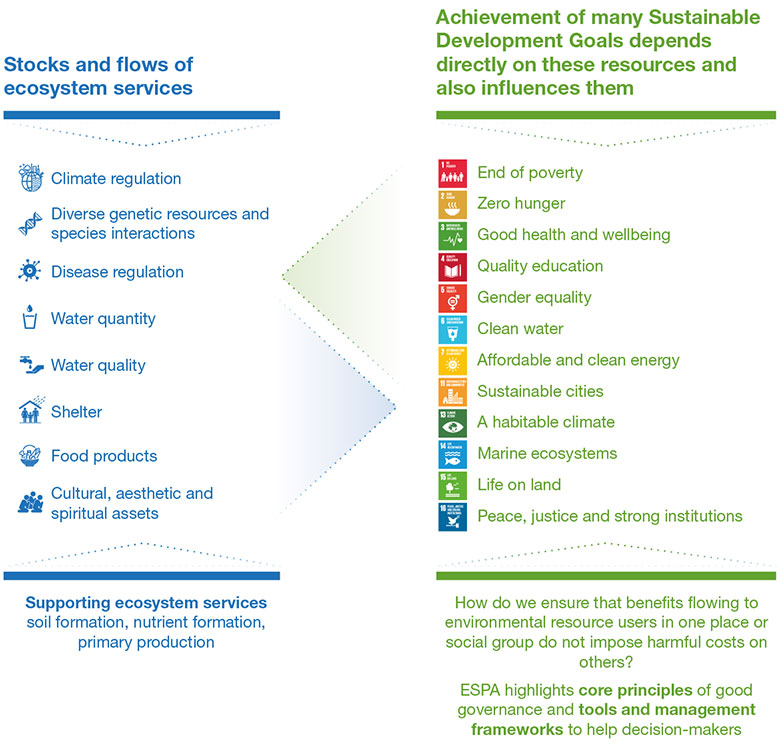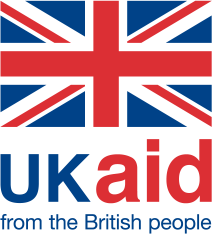PART I
Introduction
About ESPA
The Ecosystem Services for Poverty Alleviation (ESPA) programme is a global, interdisciplinary research programme that aims to give decision-makers and natural resource users the evidence they need for more sustainable ecosystem management and effective poverty reduction. Ecosystem services support human society: covering everything from freshwater flows and soil quality to fisheries productivity and climate regulation – and including cultural and spiritual values.
The Government of the United Kingdom created the ESPA research programme in 2010. It has taken on tough questions, such as: Do ecosystem services provide safety nets for people in poverty? Can ecosystem services help vulnerable people to diversify their livelihood options and security, and to enhance other aspects of their physical and mental wellbeing? How should environmental goods and services be prioritised in development, and how could they contribute to sustainable growth in developing countries and emerging economies? Are there local and regional biophysical limits and thresholds that cannot be avoided and how might they be identified? Now, eight years on, ESPA’s research is more timely and relevant than ever.
Impactful research for a rapidly changing world
As the ESPA programme draws to a close in 2018, we can look back and celebrate the substantial decreases in global poverty over the past two decades: between 1990 and 2011, almost a billion people escaped extreme poverty.[ 4 ] Yet, as governments take measures to address the Sustainable Development Goals, including the first goal – to end extreme poverty – the reality is that poverty persists in deeply entrenched pockets. It is hard to shift, requiring many policy and programme interventions. Inequality has played a role in trapping the remaining poor and could jeopardise efforts to wipe out poverty.[ 5 ] , [ 6 ] , [ 7 ]
ESPA research shines a spotlight on equity issues in the access to and use of environmental resources (see Box 1).
An environmental justice framework encompassing recognition, procedure and distributional aspects is a broad approach to understanding diverse perspectives on environmental management and change. It highlights how the costs and benefits of environmental decisions are felt across society, and how different social groups value the environment. The approach is well suited to illuminating the nature and extent of trade-offs, and to bringing forward the views of poor and marginalised stakeholders, who are often under-represented through standard environmental management frameworks.
Although equity has become more frequently mentioned in policies, it is seldom achieved in practice, particularly for the poorest members of communities and for cultural minorities. The ESPA programme and others have made some progress in developing principles and describing characteristics of equitable governance systems, which may highlight the ‘hidden costs’ of environmental interventions and help resolve trade-offs.[ 8 ]
ESPA research has looked at the multiple dimensions of human poverty and wellbeing in the changing context since the Millennium Ecosystem Assessment[ 9 ] was published. What has changed in this external context? Although poverty was conventionally measured by households’ incomes and means of livelihood, more sophisticated measures have been adopted – such as the Human Development Index[ 10 ] and more recently the Multidimensional Poverty Index[ 11 ] – which reflect data on education, health and other aspects of people’s living standards. ESPA studies have used these measures and even more sophisticated ones (see Box 2).
In the past decade, there has been an “explosion of initiatives to conceptualise and measure human wellbeing and to put it into practice in academia and policy”.[ 12 ] ESPA science emphasises that social groups (women and men, youth and elders, ethnic groups, rich and poor) use and value environmental resources differently; this needs to be recognised in decision-making. Wellbeing is a dynamic and multidimensional phenomenon incorporating objective, subjective and relational aspects.[ 13 ] A Global Person-Generated Index of wellbeing is one method applied by ESPA researchers to allow community members to express how they feel they have been affected by environmental conservation programmes – in their own terms and using multiple dimensions of wellbeing. It was used in Madagascar, where participants were asked to identify the five most important domains for their quality of life, to evaluate their experience in each one and the relative importance of the five domains. Half of respondents said that conservation programmes had had neither a positive nor negative impact on their wellbeing.[ 14 ]
The continuing growth of the world’s human population, shifts in age distribution, household size, wealth distribution, consumption, and patterns of movement, including planned and unplanned migration, all influence the interactions between people and the environmental resources on which they depend.[ 15 ] Ecosystem management has the potential to either buffer or amplify the welfare consequences of population changes and migration, but the most vulnerable groups of people are most likely to be losers, and so deserve particular attention in planning and policy processes.[ 16 ] Meanwhile, more than half of the world’s population lives in urban areas and continues to move from rural to urban areas, overall. Urban areas place heavy demands on nearby ecosystems as well as more distant ones, and have the potential to utilise environmental resources more effectively and imaginatively, especially for the benefit of the poorest residents and in peri-urban areas. The flows and management of environmental resources across the rural to urban landscape and across scales is an emergent area of scientific understanding, which ESPA research has just begun to illuminate.[ 17 ]

The environment’s ability to regulate hazards, such as floods, fires and pests, is often lost as a result of land-use intensification to provide goods such as food and fibre.
The structure of the world economy continues to evolve rapidly. This is especially the case in developing countries, where ESPA’s research has been focused. Natural resources are increasingly coming under pressure. Debates about the reuse and recycling – and the substitution – of finite natural resources have gathered pace since ESPA was founded. A truly ‘circular economy’ is still far from being realised but businesses, governments, communities and households are making the first important steps in this direction.
There is a large-scale shift towards the use of renewable natural resources such as sunlight, wave and geothermal sources for energy – driven by recognition of the dangerous consequences of greenhouse gas emissions from fossil fuels. Recent and rapid cost declines for electricity from solar photovoltaics, offshore wind and concentrating solar power are making these renewable energy alternatives fully competitive.[ 18 ] Vastly more efficient industrial processes,[ 19 ] including ‘Fourth Industrial Revolution’ technologies[ 20 ] and new manufacturing technologies from waste and recycled goods, create the possibility to reduce pollution and curb the use of raw materials.

Notwithstanding emerging technologies and innovations to break the correlation between economic growth and use of materials, humankind still depends directly and indirectly on ecosystems for food and water and for the bulk of our shelter and other material needs, and therefore our existence and wellbeing. The importance of these ‘provisioning services’ provided by the natural environment is indisputable.
What is more, healthy ecosystems carry out important regulating functions, such as regulating hazards (e.g. floods, fire, heat waves, pests) and the stocks of carbon and other elements necessary for human and other species’ survival. Regulating services are often lost – and often as a result of intensifying land use to provide food and fibre. It is difficult and costly to reverse such changes as those in the climate and water quality, which have heavy impacts on society’s poorest.
Figure 1 shows how attainment of many of the Sustainable Development Goals depends on a healthy, well-functioning natural environment.
About this report
ESPA science provides a rich, empirical evidence base on the relationships between human wellbeing and the natural environment. This report begins by providing a summary of the dynamic physical state of our environment and how it responds to ecological and social processes. This review indicates how decision-makers can think about thresholds and tipping points – and where environmental conservation, restoration and remediation are needed.
We discuss development programmes reliant on environmental resources (such as agriculture), environmental conservation and restoration programmes (such as protected areas establishment) and programmes that combine both environmental and development goals (such as community forestry schemes, urban waste water management and agriculture) – see Box 3 for examples.
Examples of development interventions
- Construction of dams, e.g. for hydropower and irrigation
- Agriculture programmes, including for food security and commodity production
- Commercial forestry schemes, e.g. timber production
- Freshwater access and sanitation schemes
- Bioenergy and biofuel development programmes, e.g. sugarcane, jatropha, palm oil, crop residues
- Wetland and urban drainage
- Marine and coastal fisheries
- Land-use changes
Examples of environmental conservation interventions
- Afforestation and reforestation schemes, including for carbon storage and sequestration, and biodiversity conservation
- Protected areas, including wildlife sanctuaries and national parks
- Coastal protection and management schemes
- Habitat restoration
- Soil and dune restoration
ESPA was created to investigate ‘ecosystem services’ and their relationship with poverty alleviation. It may surprise readers that this summary of ESPA’s research findings talks more about ‘environmental resources’ than about ‘ecosystem services’. That is because the recommendations in this report are targeted specifically to decision-makers in government, business, civil society organisations and society who are less familiar with the scientific terminology around ecosystem services. We have chosen their language. The term ‘environmental resources’ maps to typical government and business departments – such as environment agencies and corporate social responsibility teams – who we hope will act as ambassadors for ESPA’s results and seek to mainstream the programme’s key messages into their organisations and policies.
We present the main types of ecosystem services in Figure 1, which shows how: ecosystem services shape human development; human development in turn creates pressures and responses in the natural environment; and these environmental changes, in turn, instigate further human responses. The ESPA programme has influenced, and has been influenced by, a ‘kaleidoscopic’ evolution of frameworks that seek to depict these interactive, give-and-take relationships between human beings and the natural environment.[ 21 ] It is safe to say that one of the most important developments in the way scientists think about and approach ecosystem frameworks is a transition away from a mostly biophysical approach that emphasises the supply of ecosystem service provision (and so is focused on the links between biodiversity, ecosystem functions and services), to a plethora of frameworks that emphasise the human demand for and production of ecosystem services and many interactions and feedbacks. Recent scholarship and practical approaches have also recognised the plurality of values that different social groups place on the environment, and the role of power and justice via institutions and governance systems as the filter through which ecosystem services create winners and losers.[ 22 ]




